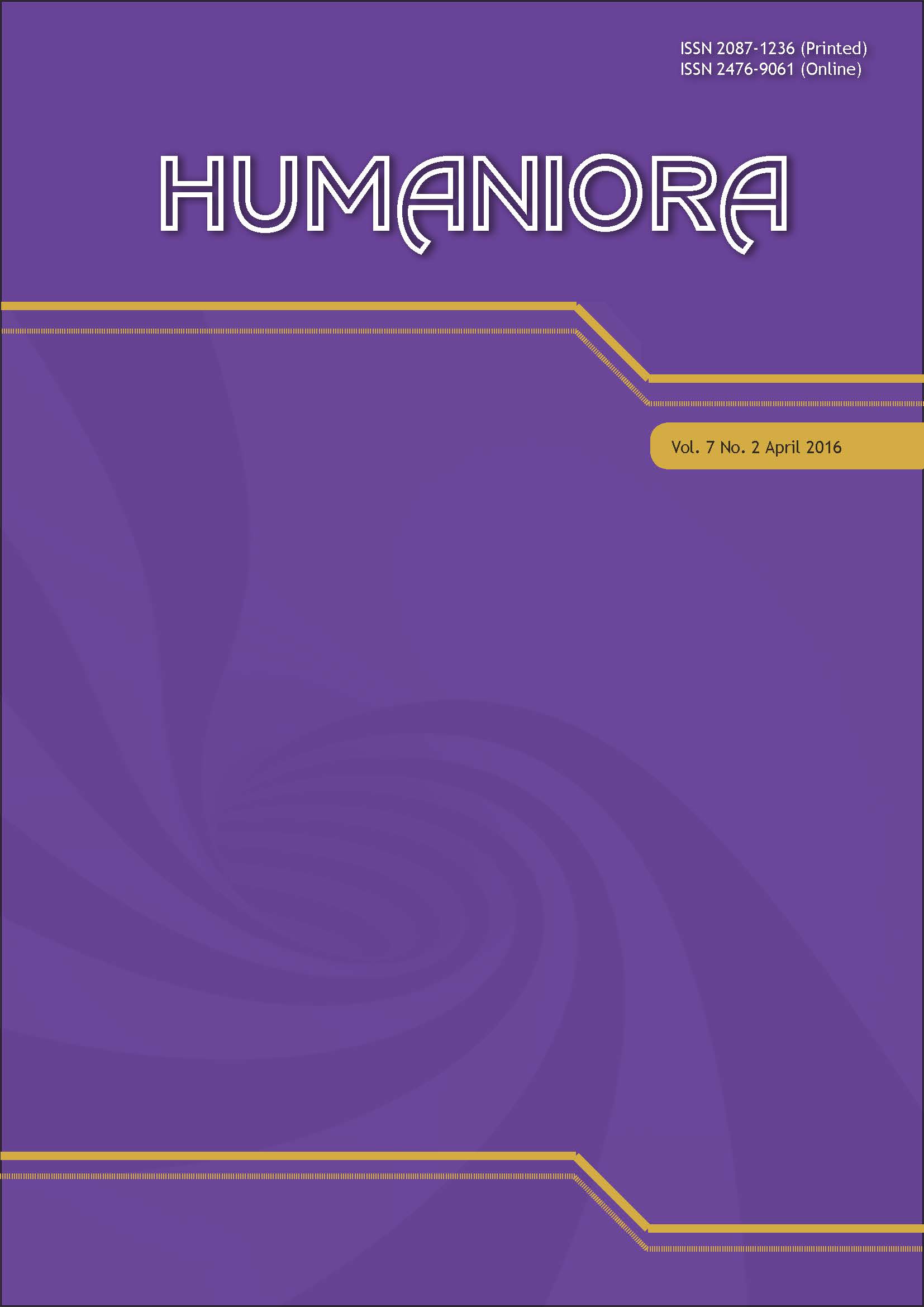Wayang Kulit and The Growth of Islam in Java
DOI:
https://doi.org/10.21512/humaniora.v7i2.3526Keywords:
wayang kulit, javanese performance, islamisation process, Islam growthAbstract
This article intended to examine the circumstance of wayang kulit during the coming of Islam in the Java island of Indonesian archipelago; how it changed and held functions within the Islamisation process of the region. The lack of written materials made this issue was somewhat unclear . In exploring these issues, this article would explain some elements surrounded Javanese wayang, specifically during the Islamisation period of Java. By showing several examples of wayang kulit characters, whether or not wayang had undertaken adaptations during this era and how far was observed. The method of this was from the data collection for that largely originated from academic books and journals from both western and Indonesian scholars, and then some visual examinations would be done upon them. The observation of each object aims to show that while to some extent wayang did undergo some alterations during this Islamisation period, however the core value of wayang performance itself was still largely Javanese, principally and aesthetically.
Â
References
Dahlan., Ghani, A., & Bin Ahmad Ishak, S. (2012). Relationship between the Art of Wayang Kulit and Disney's Twelve Principles of Animation. Revista de Cercetaresi Interventie Sociala, 37, 144-61.Retrieved January 2nd 2016 from http://www.proquest.com/.
Fattah, N. A. (1985). Metode Da’wah Wali Songo. Pekalongan: T.B. Bahagia.
Haryanto, S. (1988). Pratiwi mba Adhiluhung: Sejarah Dan Perkembangan Wayang. Jakarta: Djambatan.
Irvine, D. (1996). Leather Gods & Wooden Heroes: Java's Classical Wayang. Singapore: Times Editions.
Josselin de Jong, J. P. B. de. (1977). The Malay Archipelago as a Field of Ethnological Study. Structural Anthropology in The Netherlands: A Reader (ed.) P. E. de Josselin de Jong. The Hague: MartinusNijhoff.
Mulyono, S. (1978). Wayang: Asal-usul, Filsafat Dan Masa Depannya. Jakarta: Gunung Agung.
Poedjosoebroto, R. (1978). Wayang: Lambang Ajaran Islam. Jakarta: Pradnya Paramita.
Ricklefs, M. C. (2006-a). Mystic Synthesis in Java: A History of Islamization from the Fourteenth to the Early Nineteenth Centuries. Norwalk: East Bridge
Ricklefs, M. C. (2006-b). The Birth of the Abangan. Bijdragen Tot De Taal-, Land- En Volkenkunde / Journal of the Humanities and Social Sciences of Southeast Asia, 162(1), 35-55. Retrieved from KITLV, Royal Netherlands Institute of Southeast Asian and Caribbean Studies.
Ulbricht, H. (1970). Wayang Purwa; Shadows of the past. Kuala Lumpur: Oxford University Press.
Van Dijk, K. (1998). Dakwah and Indigenous Culture: The Dissemination of Islam. Bijdragen Tot De Taal-, Land- En Volkenkunde / Journal of the Humanities and Social Sciences of Southeast Asia, 154(2), 218-35. Retrieved from KITLV, Royal Netherlands Institute of Southeast Asian and Caribbean Studies.
Van Ness., Edward, C. & Prawirohardjo, S. (1980). Javanese Wayang Kulit: An Introduction. Kuala Lumpur: Oxford University Press.
Varela, M. E. (2014). Wayang Hip Hop: Java’s Oldest Performance Tradition Meets Global Youth Culture. Asian Theatre Journal, 31(2), 481-504.
Woodward, M. R. (1989). Islam in Java: Normative Piety and Mysticism in the Sultanate of Yogyakarta. Tucson: The University of Arizona Press.
Woodward, M. (2011). Java, Indonesia and Islam. Dordrecht: Springer
Downloads
Published
How to Cite
Issue
Section
License
Authors who publish with this journal agree to the following terms:
a. Authors retain copyright and grant the journal right of first publication with the work simultaneously licensed under a Creative Commons Attribution License - Share Alike that allows others to share the work with an acknowledgment of the work's authorship and initial publication in this journal.
b. Authors are able to enter into separate, additional contractual arrangements for the non-exclusive distribution of the journal's published version of the work (e.g., post it to an institutional repository or publish it in a book), with an acknowledgment of its initial publication in this journal.
c. Authors are permitted and encouraged to post their work online (e.g., in institutional repositories or on their website) prior to and during the submission process, as it can lead to productive exchanges, as well as earlier and greater citation of published work.
USER RIGHTS
All articles published Open Access will be immediately and permanently free for everyone to read and download. We are continuously working with our author communities to select the best choice of license options, currently being defined for this journal as follows: Creative Commons Attribution-Share Alike (CC BY-SA)




















